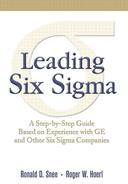Questions Concerning Financial Benefits
24. Are the published benefits of Six Sigma real?
We cannot comment on all published Six Sigma benefit claims, since we have not been privy to all of these. However, we do have evidence that the majority of published claims from major corporations are completely valid. At GE, AlliedSignal, and W. R. Grace for example, there have been rigorous financial controls and audits to validate the published benefits. In addition, many of the intangible benefits, such as preventing rather than fixing a problem—through Design for Six Sigma for example—have not been included in published benefit figures.
Therefore, it is highly probable that the true benefits of Six Sigma exceed the published figures. We believe that this is true for most companies appropriately deploying Six Sigma. Of course, it is certainly possible that some companies that have received less media scrutiny have “massaged the numbers.” Certainly companies claiming huge benefits should provide external analysts with some degree of “transparency” to the savings, so that others can see the specific sources of savings. Also, bottom line profitability should show improvement to the level claimed as Six Sigma benefits.
Part of the reason for skepticism about published financial benefits is that people simply cannot believe such huge savings are possible. Many people in the business world have gotten so used to historic levels of scrap, rework, wasted effort, and ineffectiveness, that they honestly believe such waste is an inherent part of business. Studies have shown for years that waste and rework costs in US businesses are typically 20–30% or more of sales revenue. This is a huge figure, typically much larger than gross profit! The potential for radical improvement has always been there, but the leadership, will, and a scientific, disciplined methodology have often not been present.
25. How do I sustain the gains of Six Sigma?
As explained in Chapter 6, you sustain the gains of Six Sigma in three major ways. First, you sustain the gains of individual projects that have been completed through the individual project control plan (proactive), and through periodic reviews of previously completed projects (reactive).
Second, step back from individual projects and look at maintaining the gains of the overall initiative. This can be done by developing a good implementation plan (proactive), and also by conducting periodic leadership reviews of the overall initiative (reactive).
Third, you ensure permanent benefit from Six Sigma by institutionalizing it into your culture and managerial processes, as outlined in Chapter 7.
26. How do I calculate the financial impact of a project?
This question is discussed in Chapter 5, so we will only summarize here. Members of the finance organization should be primarily responsible for calculation of financial benefits. This is their area of specialization, and they form an objective third party for projects outside Finance. Financial benefits should be segregated into hard dollars, those savings that will directly hit the bottom line, and soft dollars, savings that will hit the bottom line indirectly.
For example, reducing wasted materials by 10% is a direct savings that will show up in lower procurement costs. However, saving the time of financial analysts by improving the closing or budgeting processes will not directly hit the bottom line and is a “soft dollar savings” unless there is a headcount reduction. Note that some projects may be focused on customer or employee satisfaction, with no quantifiable financial benefit anticipated. Also, some projects may focus on top line growth rather than bottom line savings, but the same principles apply relative to hard and soft dollars.
27. Can Six Sigma successfully achieve non-financial objectives?
Absolutely! Six Sigma has most often been applied to improve the bottom line through financial savings from reduced scrap and rework. However, it is a generic improvement methodology; it can be applied to improving virtually anything. For example, Six Sigma has frequently been applied to improving relationships with customers by attacking sources of customer frustration, whether or not they directly lead to financial benefits.
Similarly, many charitable or not-for-profit organizations are implementing Six Sigma to better achieve their objectives, which are obviously not financial in nature. Examples include measuring the impact of exposing inner city children to fine arts, providing services to the disabled, or offering education and mentoring to at-risk youth. Since 9/11/2001, Six Sigma has been applied to countering terrorism, among other government applications. As previously noted, educational organizations from kindergarten through college are prime opportunities for Six Sigma improvement.
